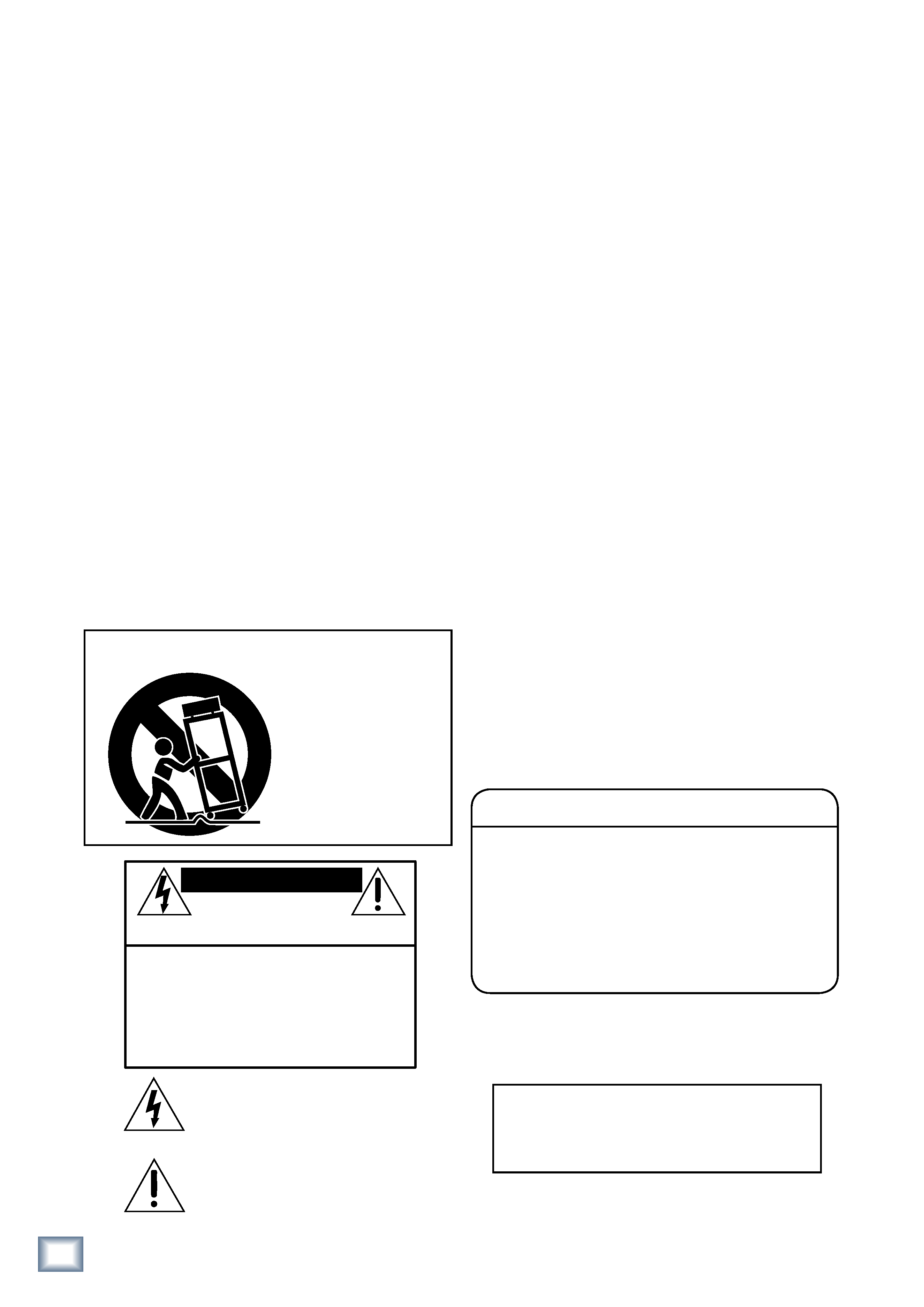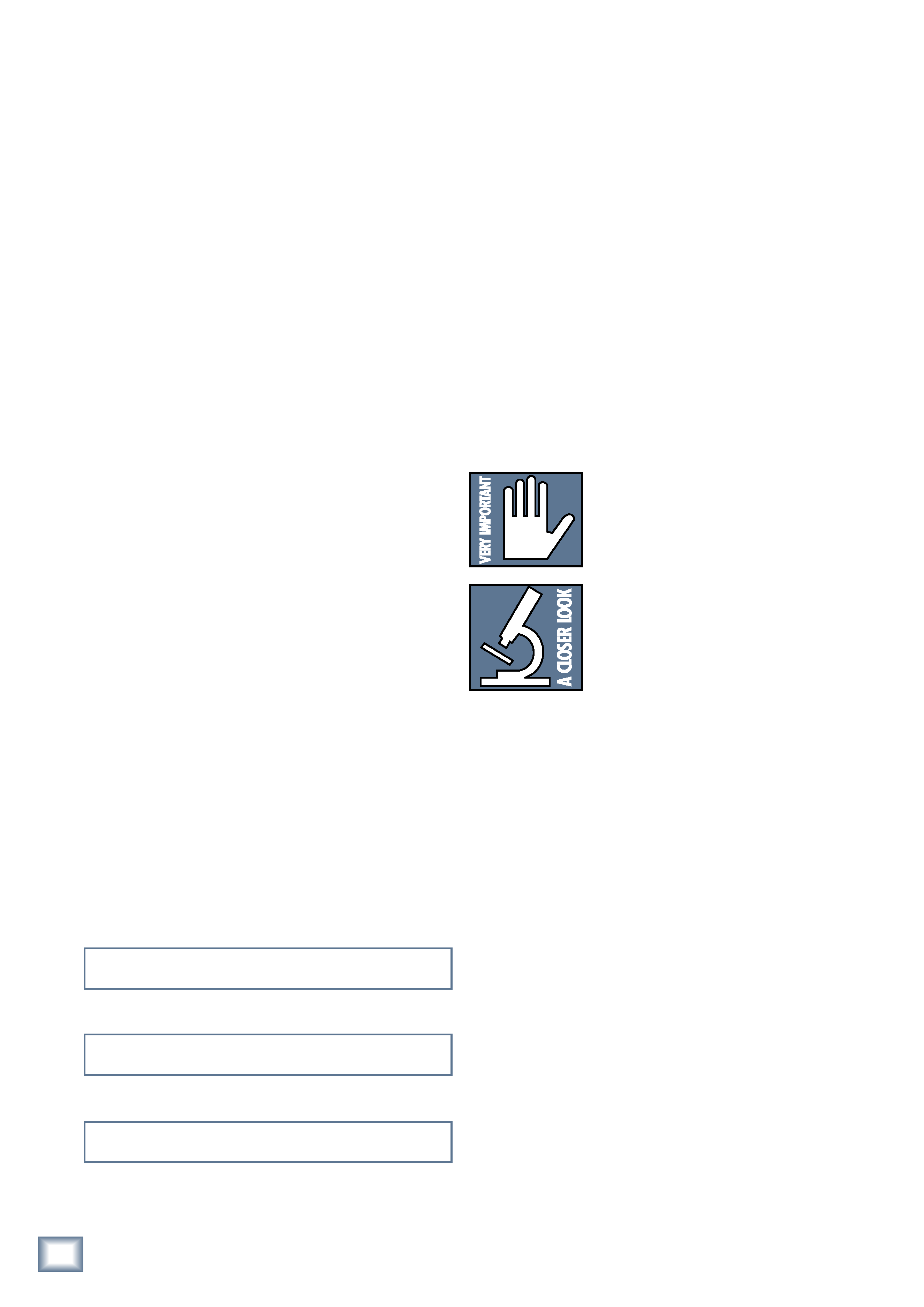
O W N E R ' S
M A N U A L
PREMIUM LIVE ANALOG MIXERS
w/PERKINS EQ & ONYX MIC PREAMPS

2
ONYX 4·Bus
ONYX
4·Bus
1. Read these instructions.
2. Keep these instructions.
3. Heed all warnings.
4. Follow all instructions.
5. Do not use this apparatus near water.
6. Clean only with dry cloth.
7. Do not block any ventilation openings. Install in accordance with the
manufacturer's instructions.
8. Do not install near any heat sources such as radiators, heat registers,
stoves, or other apparatus (including amplifiers) that produce heat.
9. Do not defeat the safety purpose of the polarized or grounding-type
plug. A polarized plug has two blades with one wider than the other.
A grounding-type plug has two blades and a third grounding prong.
The wide blade or the third prong are provided for your safety. If the
provided plug does not fit into your outlet, consult an electrician for
replacement of the obsolete outlet.
10.Protect the power cord from being walked on or pinched particularly at
plugs, convenience receptacles, and the point where they exit from the
apparatus.
11.Only use attachments/accessories specified by the manufacturer.
12.Use only with a cart, stand, tripod, bracket, or table specified by the
manufacturer, or sold with the apparatus. When a cart is used, use
caution when moving the cart/apparatus combination to avoid injury
from tip-over.
13.Unplug this apparatus during lightning storms or when unused for long
periods of time.
14.Refer all servicing to qualified service personnel. Servicing is required
when the apparatus has been damaged in any way, such as power-
supply cord or plug is damaged, liquid has been spilled or objects have
fallen into the apparatus, the apparatus has been exposed to rain or
moisture, does not operate normally, or has been dropped.
15.This Onyx mixer has been designed with Class-I construction and must
be connected to a mains socket outlet with a protective earthing con-
nection (the third grounding prong).
16.This Onyx mixer has been equipped with an all-pole, rocker-style AC
mains power switch. This switch is located on the rear panel and
should remain readily accessible to the user.
17.This apparatus does not exceed the Class A/Class B (whichever is
applicable) limits for radio noise emissions from digital apparatus as
set out in the radio interference regulations of the Canadian Department
of Communications.
ATTENTION -- Le présent appareil numérique n'émet pas de bruits
radioélectriques dépassant las limites applicables aux appareils numériques de
class A/de class B (selon le cas) prescrites dans le réglement sur le brouillage
radioélectrique édicté par les ministere des communications du Canada.
18.Exposure to extremely high noise levels may cause permanent hearing
loss. Individuals vary considerably in susceptibility to noise-induced
hearing loss, but nearly everyone will lose some hearing if exposed to
sufficiently intense noise for a period of time. The U.S. Government's
Occupational Safety and Health Administration (OSHA) has specified
the permissible noise level exposures shown in the following chart.
According to OSHA, any exposure in excess of these permissible limits
could result in some hearing loss. To ensure against potentially danger-
ous exposure to high sound pressure levels, it is recommended that all
persons exposed to equipment capable of producing high sound pres-
sure levels use hearing protectors while the equipment is in operation.
Ear plugs or protectors in the ear canals or over the ears must be worn
when operating the equipment in order to prevent permanent hearing
loss if exposure is in excess of the limits set forth here.
Important Safety Instructions
WARNING -- To reduce the risk of fire or
electric shock, do not expose this apparatus
to rain or moisture.
Duration Per Day
Sound Level dBA,
Typical
In Hours
Slow Response
Example
8
90
Duo in small club
6
92
4
95
Subway Train
3
97
2
100
Very loud classical music
1.5
102
1
105
Tami screaming at Adrian about deadlines
0.5
110
0.25 or less
115
Loudest parts at a rock concert
PORTABLE CART WARNING
Carts and stands - The
Component should be used
only with a cart or stand
that is recommended by
the manufacturer.
A Component and cart
combination should be
moved with care. Quick
stops, excessive force, and
uneven surfaces may cause
the Component and cart
combination to overturn.
CAUTION AVIS
RISK OF ELECTRIC
SHOCK
DO NOT OPEN
RISQUE DE CHOC ELECTRIQUE
NE PAS OUVRIR
CAUTION: TO REDUCE THE RISK OF ELECTRIC SHOCK
DO NOT REMOVE COVER (OR BACK)
NO USER-SERVICEABLE PARTS INSIDE
REFER SERVICING TO QUALIFIED PERSONNEL
ATTENTION: POUR EVITER LES RISQUES DE CHOC
ELECTRIQUE, NE PAS ENLEVER LE COUVERCLE. AUCUN
ENTRETIEN DE PIECES INTERIEURES PAR L'USAGER. CONFIER
L'ENTRETIEN AU PERSONNEL QUALIFIE.
AVIS: POUR EVITER LES RISQUES D'INCENDIE OU
D'ELECTROCUTION, N'EXPOSEZ PAS CET ARTICLE
A LA PLUIE OU A L'HUMIDITE
The lightning flash with arrowhead symbol within an equilateral
triangle is intended to alert the user to the presence of uninsulated
"dangerous voltage" within the product's enclosure, that may be
of sufficient magnitude to constitute a risk of electric shock to persons.
Le symbole éclair avec point de flèche à l'intérieur d'un triangle
équilatéral est utilisé pour alerter l'utilisateur de la présence à
l'intérieur du coffret de "voltage dangereux" non isolé d'ampleur
suffisante pour constituer un risque d'éléctrocution.
The exclamation point within an equilateral triangle is intended to
alert the user of the presence of important operating and maintenance
(servicing) instructions in the literature accompanying the appliance.
Le point d'exclamation à l'intérieur d'un triangle équilatéral est
employé pour alerter les utilisateurs de la présence d'instructions
importantes pour le fonctionnement et l'entretien (service) dans le
livret d'instruction accompagnant l'appareil.

Part No. 0015958-00 Rev. A 1/06
©2006 LOUD Technologies Inc. All Rights Reserved.
3
Owner's Manual
Owner'
sManual
Don't forget to visit our website at www.mackie.com for more
information about this and other Mackie products.
R
Table of Contents
Introduction................................................................................................................4
Getting Started..........................................................................................................5
Zero the Controls.......................................................................................................................................5
Connections.................................................................................................................................................5
Set the Levels ..............................................................................................................................................5
Instant Mixing.............................................................................................................................................5
Hookup Diagrams..................................................................................................... 6
Onyx 4·Bus Features...............................................................................................10
Mono Channel Strips...............................................................................................................................10
Stereo Channel Strips .............................................................................................................................13
Matrix, Compressor, and Metering Section......................................................................................15
Phones/Monitor, Solo, Mono, and Talkback Section....................................................................17
Auxiliary Section......................................................................................................................................18
Group Section ..........................................................................................................................................20
Rear Panel...................................................................................................................................................21
Appendix A: Service Information........................................................................25
Warranty Service......................................................................................................................................25
Troubleshooting.......................................................................................................................................25
Repair .........................................................................................................................................................26
Appendix B: Connections ......................................................................................27
Appendix C: Technical Info ..................................................................................30
Onyx 4·Bus Specifications....................................................................................................................30
Onyx 4·Bus Dimensions .........................................................................................................................31
Onyx 4·Bus Block Diagram....................................................................................................................32
Onyx 4·Bus Gain Structure Diagram................................................................................................. 34
Onyx 4·Bus Limited Warranty.............................................................................35

4
ONYX 4·Bus
ONYX
4·Bus
Introduction
Thank you for choosing a Mackie Onyx 4·Bus profes-
sional live mixing console. The Onyx 4·Bus mixers fea-
ture all-new analog circuitry and the latest technologies
for live sound reinforcement in a durable, road-worthy
package.
The Onyx 4·Bus mixing consoles replace the legend-
ary SR24·4 and SR32·4 VLZ PRO mixers. The new Onyx
versions of these mixers maintain the same physical
size, channel count and features of the originals, while
adding a variety of new and improved features.
The Onyx 4·Bus consoles are equipped with our new
premium precision-engineered, studio-grade Onyx mic
preamps. Mackie is renowned for the high-quality mic
preamps used in our mixers, and the Onyx mic pre's are
better than ever, with specifications rivaling expensive
stand-alone boutique mic preamplifiers.
Each mono channel strip features an individual phan-
tom power switch, low-cut filter, mic input pad, pre-EQ
channel insert, and an all new four-band EQ design with
sweepable mids and EQ bypass switch.
All mono channels have six Aux sends, Pan, Mute, PFL
Solo, 100 mm Fader, Group and Main Mix assign, and
four signal-level indicators. In addition, balanced direct
outputs are provided on DB-25 connectors (eight chan-
nels per connector) for multitrack recording.
The master section features two Stereo Returns, six
Master Aux sends, four Group Masters, a 6x2 Matrix, a
Phones/Monitor section, and a Talkback section with
routing switches that allow you to communicate through
the Aux Sends and the L/R mix.
A new feature with the Onyx 4·Bus mixers is an analog
stereo compressor/limiter that can be inserted at the out-
put of the L/R main mix, or the Group 1/2 or 3/4 outputs.
HOW TO USE THIS MANUAL
We know that many of you can't wait to get your new
mixing console hooked up, and you're probably not going
to read the manual first (sigh!). So the next section is a
Quick-Start Guide to help you get the mixer set up fast
so you can start using it right away. Right after that are
the ever popular hook-up diagrams that show typical
mixer setups for live sound, recording and mixdown.
Then, when you have time, read the Features Descrip-
tion section. This describes every knob, button, and
connection point on the Onyx 4·Bus, roughly following
the signal flow through the mixer.
Throughout this section you'll find illustrations with
each feature numbered. If you want to know more about
a feature, simply locate it on the appropriate illustra-
tion, notice the number attached to it, and find that
number in the nearby paragraphs.
This icon marks information that is
critically important or unique to the
Onyx 4·Bus. For your own good, read
them and remember them. They will
be on the final test.
This icon leads you to in-depth
explanations of features and practi-
cal tips. While not mandatory, they
usually have some valuable nugget of
information.
A PLUG FOR THE CONNECTOR SECTION
Appendix B is a section on connectors: XLR connec-
tors, balanced connectors, unbalanced connectors, and
special hybrid connectors.
More resources on our website at www.mackie.com.
Click on Support to find answers to many of your ques-
tions. The FAQ (Frequently Asked Questions) section is
filled with answers to many of the questions our Techni-
cal Support staff has fielded over the years.
Check out the glossary for explanations of many of the
pro-audio terms used in our manuals.
Visit our forums to seek help from our online commu-
nity of Mackie users.
Please write your serial number here for future
reference (i.e., insurance claims, tech support,
return authorization, etc.)
Purchased at:
Date of purchase:

5
Owner's Manual
Owner'
sManual
Getting Started
READ THIS PAGE!!
Even if you're one of those people
who never read manuals, all we ask
is that you read this page now before
you begin using the Onyx 4·Bus.
You'll be glad you did!
Zero the Controls
1. Turn down the channel GAIN, AUX, and Fader con-
trols, and center the channel EQ and PAN controls.
2. Set all push button switches to their "out" positions.
3. In the Master section, turn all the rotary knobs
"down," the switches "out," and the faders down.
4. Turn the POWER switch off.
Connections
If you already know how you want to connect the Onyx
4·Bus mixing console, go ahead and connect the inputs
and outputs the way you want them. If you just want to
get sound through the mixer, follow these steps:
1. Plug a microphone or other signal source into chan-
nel 1's MIC or LINE input [73/74].
2. Plug in the detachable linecord, connect it to an AC
outlet, and turn on the Onyx 4·Bus' POWER switch
[90].
3. Connect cables from the Onyx 4·Bus' MAIN OUTS
[82] (XLR connectors or 1/4" TRS connectors on
the rear panel) to your amplifier or active speakers.
4. Hook up speakers to the amp and turn it on. If the
amplifier has level controls, set them however the
manufacturer recommends (usually all the way up).
Set the Levels
To set the channel GAIN controls, it's not even neces-
sary to hear what you're doing at the outputs of the
mixer. If you want to listen while you work, plug head-
phones into the PHONES jack [46] on the front panel,
then set the PHONES knob [47] about one-quarter of
the way up and the SOLO LEVEL [49] about halfway up.
The following steps must be performed one channel at
a time.
1. Push in the channel's PFL [18] solo switch.
2. Play something into the selected input. This could
be an instrument, a singing or speaking voice, or
a line input such as a CD player or tape recorder
output. Be sure that the volume of the input source
is the same as it would be during normal use. If it
isn't, you might have to readjust these levels during
the middle of the set.
3. Adjust the channel's GAIN [4] control so that the
LEDs on the Left MAIN MIX meter stay around "0"
and never go higher than "+10."
4. If you'd like to apply some EQ, do so now and return
to step 3. Remember to push in the EQ IN/OUT
[11] switch or the EQ controls won't do anything.
5. Disengage that channel's PFL solo switch.
6. Repeat for each channel.
Instant Mixing
1. Leave the microphone plugged into channel 1 and
connect a keyboard, guitar or other instrument to
channel 2. Be sure to "Set the Levels" for channel 2
as described above.
2. To get sound out of the speakers, push in the MAIN
MIX assign switch [17] next to the faders on chan-
nels 1 and 2, turn up channel 1 and 2 faders [15] to
the "U" mark and slowly turn up the MAIN MIX [72]
fader to a comfortable listening level.
3. Sing and play. You're a star! Adjust the faders for
channels 1 and 2 to bring your voice and your
instrument up and down to create your own mix.
Other Nuggets of Wisdom
·
For optimum sonic performance, the channel and
MAIN MIX faders should be set near the "U" (unity
gain) markings.
·
Always turn the MAIN MIX faders, GROUP faders,
and MONITOR knob down before making connec-
tions to and from your Onyx 4·Bus.
·
When you shut down your equipment, turn off the
amplifiers first. When powering up, turn on the
amplifiers last.
·
Never listen to loud music for prolonged periods.
Please see the Safety Instructions on page 2 for
information on hearing protection.
·
Save the shipping box! You may need it someday,
and you don't want to have to pay for another one.
That's it for the "Getting Started" section. Next comes
the "Hookup" section that shows you some typical ways
that you might use the Onyx 4·Bus in real applications.
After that, take the grand tour of the mixer, with de-
scriptions of every knob, button, input, and output. We
encourage you to take the time to read all of the feature
descriptions, but at least you know it's there if you have
any questions.
